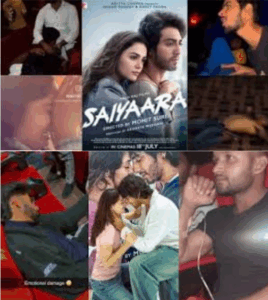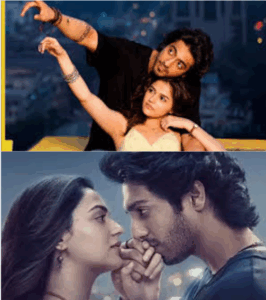Saiyaara: Wild Fans Crying and Screaming After Watch Ahaan Panday And Aneet Padda’s Movie
In recent days, a film titled Sayara has taken India by storm, not just for its narrative or performances, but for the overwhelming emotional reactions it has evoked in viewers—especially Gen Z audiences. Videos emerging from cinema halls across the country show young moviegoers crying, screaming, collapsing, and engaging in dramatic behavior that many are finding both baffling and thought-provoking. In a time when attention spans are dwindling and theatrical releases struggle to compete with streaming platforms, Sayara seems to have done the impossible: it has created a shared cinematic experience so intense that it physically and emotionally overwhelms its audience.
The film marks the debut of Aan Pandey and Aniet Padda, two young actors whose onscreen chemistry has struck a chord with a generation hungry for authentic romantic storytelling. But more than the storyline or acting, it is the visceral reactions of viewers that have made headlines. In multiple viral clips, audiences are seen reacting to the film in ways that blur the line between fandom and hysteria. One video shows a young man climbing onto his seat, screaming at the screen, tearing off his shirt, and then lying on the floor of the theater in an emotionally charged state. In another instance, a viewer reportedly fainted during a particularly emotional sequence, requiring staff to revive him by sprinkling water on his face. Yet another video shows a young man appearing to enter a state of emotional shock, unable to process what he just witnessed. His friends try to bring him back to his senses, visibly concerned.
Across the country, boys and girls are seen weeping uncontrollably as the credits roll. There are scenes of groups hugging, crying, some even sitting motionless, stunned by the emotional weight of what they’ve just experienced. For some, Sayara has become more than a film—it has become a mirror reflecting their inner emotional worlds, their heartbreaks, their yearning for connection. And yet, while some viewers find solidarity and catharsis in these moments, others watching these videos from the outside are left confused, even annoyed.
The internet, as always, is divided. One user commented sarcastically, “It’s just a movie. Why such overreaction?” Another wrote, “This is peak unemployment behavior,” while others labeled it a publicity stunt or “paid drama.” Some questioned the priorities of youth today, with remarks like, “This is what happens when education is ignored,” or “And they say the government doesn’t provide jobs.” These comments highlight a deeper tension between generations and ideologies—one that views emotional vulnerability as immaturity, and another that sees it as authenticity.

So what is it about Sayara that has touched such a nerve? Why are these emotional eruptions happening now, and why with this particular film? To understand that, we must first acknowledge that cinema, in India especially, has never merely been entertainment. For decades, films have served as vessels of dreams, identity, escape, and rebellion. From the golden era of Bollywood to the multiplex revolution, Indian cinema has shaped and reflected the emotions of a complex, diverse population. But in recent years, something has shifted. Gen Z, a generation born in a world of social media, anxiety, isolation, and fast-changing relationships, is finding solace in storytelling that resonates with their struggles. Sayara, it seems, has tapped into those exact emotional frequencies.
It is also important to consider the psychological context. In a world where emotional expression is often mocked or suppressed—especially among young men—cinema can become a rare safe space for release. A darkened hall, a moving soundtrack, a story of love or loss—these elements can trigger deeply buried emotions. Perhaps that young man screaming in the theater wasn’t just reacting to the film’s climax, but to something unresolved in his own life. Maybe the boy who fainted wasn’t merely overwhelmed by a scene, but by months of pent-up feelings. In this light, Sayara becomes not just a film, but a cultural moment where collective emotion is not only visible but validated.
Yet, this phenomenon has sparked criticism from those who view such reactions as exaggerated or performative. Some allege that the videos are staged, designed to generate buzz and box office returns. Others dismiss the young audience’s response as immaturity, failing to grasp the seriousness of such displays. But to reduce this phenomenon to mere theatrics would be to ignore a generation’s growing need for emotional connection. At its heart, the reaction to Sayara is a reflection of the internal chaos many young people feel in today’s fast-paced, hyper-connected, and often lonely world.
This isn’t the first time a film has triggered extreme reactions. Throughout cinematic history, there have been reports of audiences fainting during horror films, crying uncontrollably during tragic scenes, or even falling into depression after emotionally draining stories. What makes Sayara unique is the scale and visibility of these reactions, amplified by the internet and instantly shared on platforms like Instagram, TikTok, and YouTube. Every crying face, every theatrical outburst is captured and commented upon, turning real emotions into viral content.

There is also an underlying class and generational bias in the criticism being hurled at Sayara’s audience. The assumption that only the “uneducated” or “unemployed” would behave this way is both dismissive and problematic. Emotional expression is not a sign of a lack of intelligence; it is a sign of being human. In fact, the very impulse to mock such behavior points to a cultural discomfort with vulnerability—especially male vulnerability—that still exists in many parts of Indian society.
What we are witnessing with Sayara may very well be the beginning of a new kind of cinema culture in India—one where films are not just consumed but experienced with full emotional participation. It speaks to a youth audience that is tired of pretending, that finds pride in feeling deeply. Whether one views this as progress or as excessive is a matter of perspective. But what cannot be denied is that Sayara has struck a chord, and its impact will likely ripple far beyond ticket sales.
Critics and psychologists alike might find value in studying the Sayara effect. What triggers such powerful identification with fictional characters? How does communal viewing heighten emotional responses? Could cinema actually become a form of collective therapy in a society still grappling with mental health stigma? These are questions worth exploring. If a film can unlock emotions in people who otherwise suppress them, perhaps it is doing something important—even revolutionary.

For the filmmakers, Aan Pandey and Aniet Padda, the reception to Sayara is both a dream and a responsibility. Their performances have become catalysts for conversations much bigger than the story itself. It remains to be seen how they handle the fame and expectations that come with such a breakout. More importantly, how the industry will respond to this kind of emotionally immersive filmmaking will be a trend to watch.
Some argue that these reactions are temporary, fueled by social media virality and peer influence. That may be true. The internet is notorious for building hype and tearing it down just as quickly. But even if the intensity fades, the emotional truth behind it remains. For a brief moment, thousands of young Indians allowed themselves to feel openly and unapologetically inside public spaces. That alone is significant.
In the end, whether one laughs at or relates to the Sayara hysteria, it’s clear that something real is happening beneath the surface. It is a testament to the power of storytelling, the hunger for emotional catharsis, and the unique place cinema holds in Indian hearts. Perhaps instead of mocking or dismissing these reactions, it’s time we asked what they’re trying to tell us—about this generation, about society, and about ourselves.
Play video :
News
Katrina Kaif’s Father-In-Law Sham Kaushal Wanted To Jump From 3rd Floor
Katrina Kaif’s Father-In-Law Sham Kaushal Wanted To Jump From 3rd Floor Shyam Kaushal, Katrina Kaif’s father-in-law and Vicky Kaushal’s father,…
Hansika Motwani and Sohael Khaturiya Heading For Divorce After 2 years Of Wedding?
Hansika Motwani and Sohael Khaturiya Heading For Divorce After 2 years Of Wedding? Bollywood actress Hansika Motwani, once known for…
Did Kapil Sharma again attacked with Gun Shot? Life Thread Incident Stopped Great Kapil Show Shoot
Did Kapil Sharma again attacked with Gun Shot? Life Thread Incident Stopped Great Kapil Show Shoot . . . Gunfire…
The complete truth behind the viral news of Asrani’s death! Actor Asrani Died At The Age Of 84, Asrani Death News
The complete truth behind the viral news of Asrani’s death! Actor Asrani Died At The Age Of 84, Asrani Death…
Urfi Javed Painful Lip Filler Leaves Face Severely Swollen and Unrecognisable
Urfi Javed Painful Lip Filler Leaves Face Severely Swollen and Unrecognisable In an era dominated by filters, flawless selfies, and…
An accident happened with actor Shahrukh Khan on the set of the film ‘King’! Shahrukh Khan Sad News
An accident happened with actor Shahrukh Khan on the set of the film ‘King’! Shahrukh Khan Sad News . ….
End of content
No more pages to load










